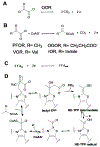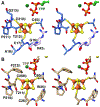Structural organization of pyruvate: ferredoxin oxidoreductase from the methanogenic archaeon Methanosarcina acetivorans
- PMID: 39265575
- PMCID: PMC11956543
- DOI: 10.1016/j.str.2024.08.011
Structural organization of pyruvate: ferredoxin oxidoreductase from the methanogenic archaeon Methanosarcina acetivorans
Abstract
Enzymes of the 2-oxoacid:ferredoxin oxidoreductase (OFOR) superfamily catalyze the reversible oxidation of 2-oxoacids to acyl-coenzyme A esters and carbon dioxide (CO2)using ferredoxin or flavodoxin as the redox partner. Although members of the family share primary sequence identity, a variety of domain and subunit arrangements are known. Here, we characterize the structure of a four-subunit family member: the pyruvate:ferredoxin oxidoreductase (PFOR) from the methane producing archaeon Methanosarcina acetivorans (MaPFOR). The 1.92 Å resolution crystal structure of MaPFOR shows a protein fold like those of single- or two-subunit PFORs that function in 2-oxoacid oxidation, including the location of the requisite thiamine pyrophosphate (TPP), and three [4Fe-4S] clusters. Of note, MaPFOR typically functions in the CO2 reductive direction, and structural comparisons to the pyruvate oxidizing PFORs show subtle differences in several regions of catalytical relevance. These studies provide a framework that may shed light on the biochemical mechanisms used to facilitate reductive pyruvate synthesis.
Copyright © 2024 Elsevier Inc. All rights reserved.
Conflict of interest statement
Declaration of interests The authors declare no competing interests.
Figures







Similar articles
-
The redox landscape of pyruvate:ferredoxin oxidoreductases reveals often conserved Fe-S cluster potentials.J Biol Chem. 2025 Jun 16;301(8):110380. doi: 10.1016/j.jbc.2025.110380. Online ahead of print. J Biol Chem. 2025. PMID: 40533063 Free PMC article.
-
Binding site for coenzyme A revealed in the structure of pyruvate:ferredoxin oxidoreductase from Moorella thermoacetica.Proc Natl Acad Sci U S A. 2018 Apr 10;115(15):3846-3851. doi: 10.1073/pnas.1722329115. Epub 2018 Mar 26. Proc Natl Acad Sci U S A. 2018. PMID: 29581263 Free PMC article.
-
The iron-sulfur centers of the pyruvate:ferredoxin oxidoreductase from Methanosarcina barkeri (Fusaro).FEBS Lett. 1997 Sep 8;414(2):209-12. doi: 10.1016/s0014-5793(97)00998-8. FEBS Lett. 1997. PMID: 9315687
-
Radical reactions of thiamin pyrophosphate in 2-oxoacid oxidoreductases.Biochim Biophys Acta. 2012 Nov;1824(11):1291-8. doi: 10.1016/j.bbapap.2011.11.010. Epub 2011 Dec 8. Biochim Biophys Acta. 2012. PMID: 22178227 Free PMC article. Review.
-
Structure and electron transfer mechanism of pyruvate:ferredoxin oxidoreductase.Curr Opin Struct Biol. 1999 Dec;9(6):663-9. doi: 10.1016/s0959-440x(99)00027-5. Curr Opin Struct Biol. 1999. PMID: 10607667 Review.
Cited by
-
The redox landscape of pyruvate:ferredoxin oxidoreductases reveals often conserved Fe-S cluster potentials.J Biol Chem. 2025 Jun 16;301(8):110380. doi: 10.1016/j.jbc.2025.110380. Online ahead of print. J Biol Chem. 2025. PMID: 40533063 Free PMC article.
References
-
- Charon MH, Volbeda A, Chabriere E, Pieulle L, and Fontecilla-Camps JC (1999). Structure and electron transfer mechanism of pyruvate:ferredoxin oxidoreductase. Curr Opin Struct Biol 9, 663–669. - PubMed
-
- Ragsdale SW (2003). Pyruvate ferredoxin oxidoreductase and its radical intermediate. Chem Rev 103, 2333–2346. - PubMed
-
- Yun NR, Arai H, Ishii M, and Igarashi Y (2001). The genes for anabolic 2-oxoglutarate: ferredoxin oxidoreductase from Hydrogenobacter thermophilus TK-6. Biochem Biophys Res Commun 282, 589–594. - PubMed
Publication types
MeSH terms
Substances
Grants and funding
LinkOut - more resources
Full Text Sources

